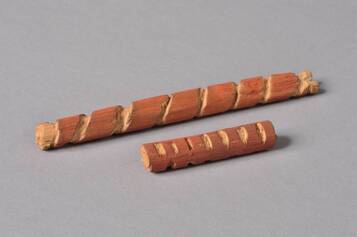| Coordinates WGS84 | 13°22'S, 141°44'E -13.36, 141.73 |
HEM68322_a
Title: A message stick held in the Herrnhut Ethnological Museum (Völkerkundemuseum Herrnhut)
Description: HEM online catalogue: Message sticks (Botenstäbe)
Message: Christmas celebrations invitation - seven notches, one for each remaining day
Creator of Object: Unknown
Date Created: 1913
Notes on date created: terminus ante quem
Item type: message stick in a collection
Subtype: traditional
State/Territory: QLD
Notes on linguistic areas: The message stick is associated with North Queensland, Cape York Peninsula, Aurukun (Wikmungkan)
Dimension 1: 160mm Dimension 2: 15mm Dimension 3: 15mm
Materials: wood
Techniques: carved and painted
Date collected: 1913
Institution/Holder file: Herrnhut Ethnological Museum (Völkerkundemuseum Herrnhut) object identifier: 68322 a, b
Collector: Richter, Arthur Eduard Immanuel (1875-1945)?
Coordinates: 13°21'30.200400"S,141°43'40.800000"E (-13.358389, 141.728)
Media copyright: Herrnhut Ethnological Museum (Völkerkundemuseum Herrnhut)
Notes on coordinates: Absolute coordinates for Aurukun, Queensland, per Google maps. Wikipedia: The Aurukun Mission (known then as the Archer River Mission Station) was established on 4 August 1904.
URL institution: https://skd-online-collection.skd.museum/Details/Index/1524545
Notes: 2.5.24 NR: For more detail about this object see Erckenbrecht, Corinna. 2017. "German Moravian missionaries on western Cape York Peninsula and their perception of the local Aboriginal people and languages." In German ethnography in Australia, edited by Nicolas Peterson and Anna Kenny, 137-165. Canberra: ANU Press. HEM online catalogue: "Messenger staffs were often used to transmit messages between individual Aboriginal groups. They were usually not particularly elaborately made, as they were usually only used once. The most common characters found on messenger staffs are notches carved either on the edge or on the surface of the staff. Most of the time, the messengers with messenger staffs were heads of local groups who wanted to invite neighboring Aborigines to festivals and gatherings, for example to hunts for emus and wallabies, initiation rites or Cooroborees (dance festivals). Messenger staffs could also be sent between individuals to request the production of special equipment, weapons, etc., or to initiate barter transactions. Some messenger sticks contained information about illnesses and deaths. They could also send warnings about the arrival of enemy groups or declarations of war to settle disputes. Each messenger staff contained at the same time the authentication of the messenger and the truthfulness of his message. In many cases, the symbols on the messenger staff served as a reminder to the messenger. Unfortunately, no records are known about the messenger staff of the Herrnhut Ethnological Museum. However, since the origin of the object was attributed to the area around the Aurukun mission station (North Queensland), C.Erckenbrecht suspects a connection to an event from 1911: Christmas celebrations at the mission stations were very popular among the Aborigines. Large groups of Aborigines often arrived at the mission station for this festival. But since they didn't have a calendar, some groups came to the festival too early in 1911 and left again because nothing happened. Missionary Richter had a messenger sent after them with the message to come back in seven days, then it would be Christmas. He gave the messenger a messenger staff with seven notches, one for each remaining day. (VMH, JF 2020)" This record represents the longer object out of the two in the attached image.
Media Files:
Data Entry: Nitzan Rotman
Related Entries: HEM68322_b
